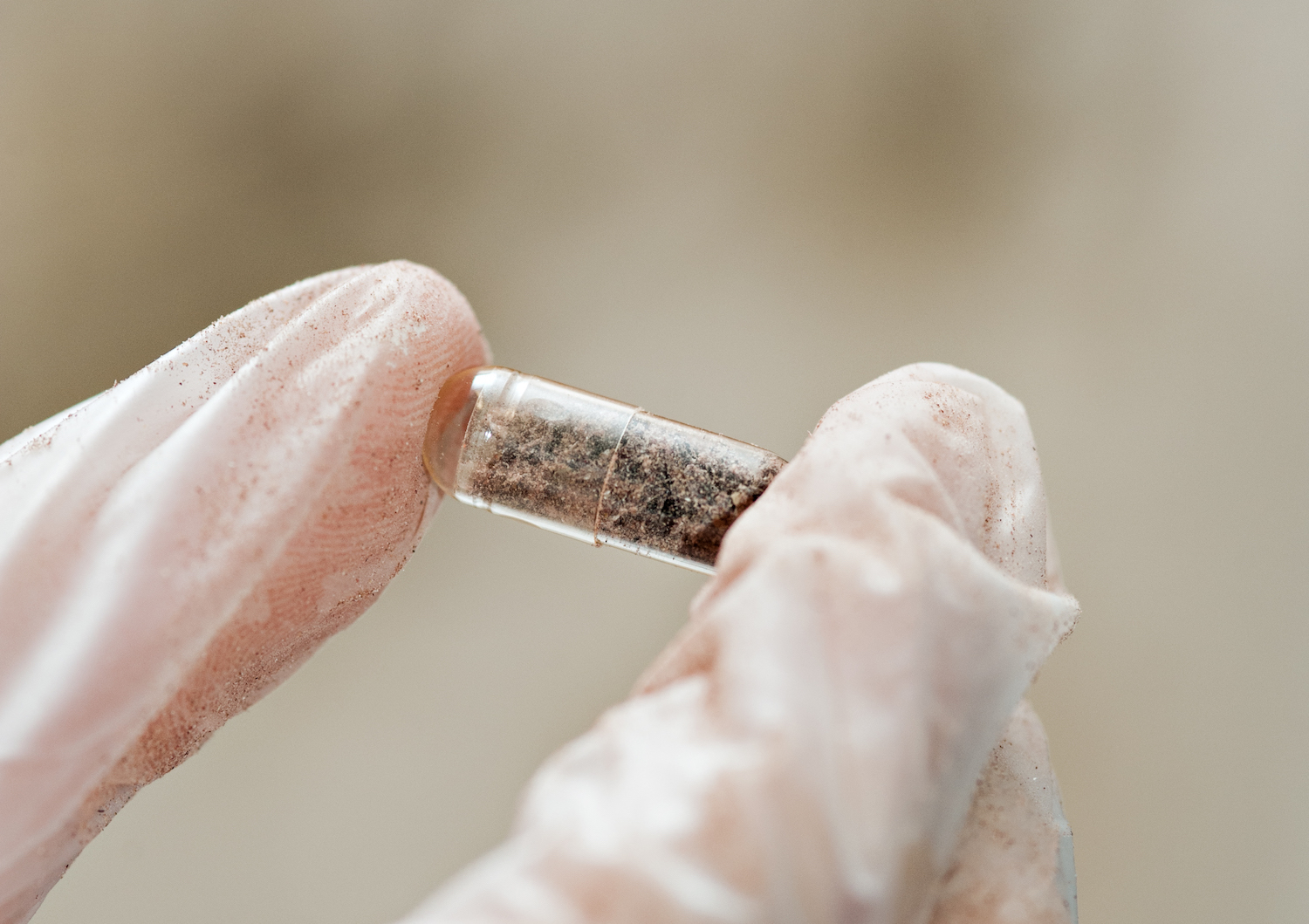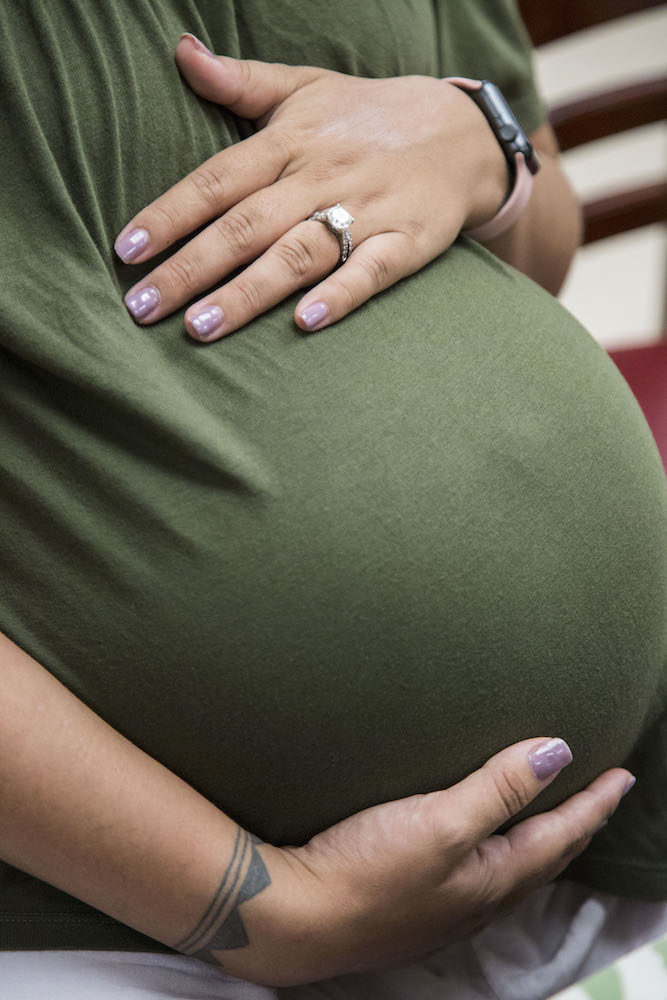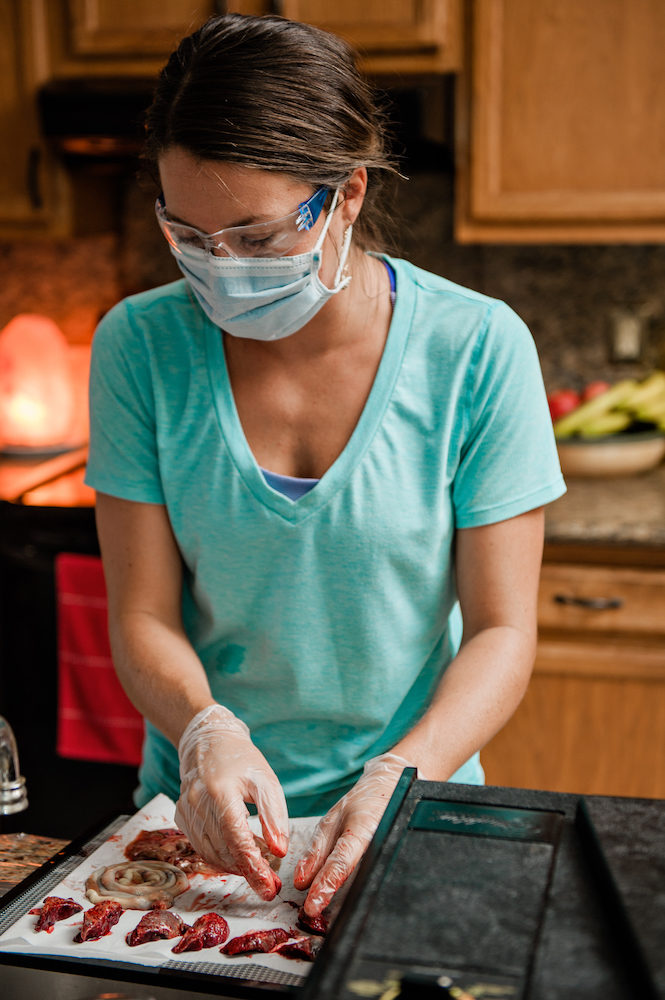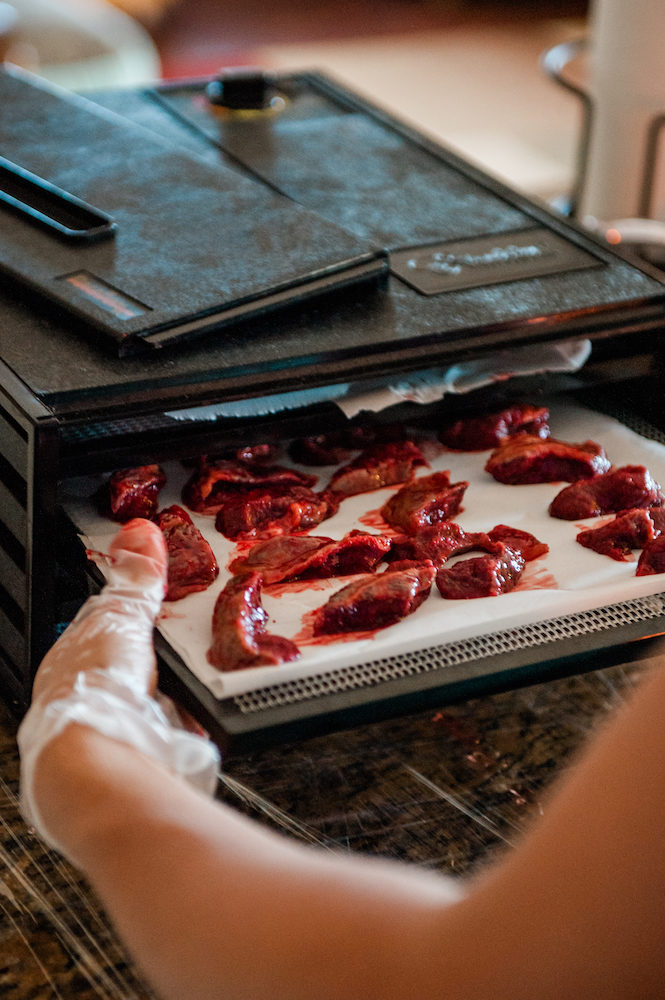Images by Marie Eriel Hobro and John Hook
The placenta is a study in both substance and sustenance. With a name derived from “plakous,” Greek for “flat cake,” the placenta is hefty and oblong, averaging nine inches wide and one inch thick. It is dense and spongey and slab-like, with a rich vein system that radiates outward in myriad root-like lobes. Though no two placentas look alike, most subscribe to a palette of deep, meaty reds and dusky blue-purples, with large surface areas that outpace placentas of other mammals due to the human fetus’ enormous nutrient demand. Engorged with blood and attached to the interior wall of the mother’s uterus, the placenta is an organ of consequence during pregnancy. For nine months, it plays many critical roles: a conduit for nutrients and hormones, a filter against toxins, a sensor determining the needs of the fetus, a manufacturer of hormones for both fetus and mother. Once the mother gives birth, the placenta is expunged, hence the term, “afterbirth.” However, outside the womb, the placenta’s mystique remains in two arenas: cultural practices and the wellness industry.
I.
Keaweokapōhōkū Michael Ito was born in the hushed, early morning hours of a rising autumn moon. On a day marked by another rising moon, two months later, the infant’s family gathered in a quiet ceremony to bury his ‘iewe, or placenta, on his father’s ancestral homelands in Hilo on Hawai‘i Island. Doing so would spiritually link the child to his ‘āina, or land. To the first-time parents, this Hawaiian birthing practice concept felt more than just pono, or right. It felt destined.
The preparations for the ceremony were simple and intentional. A small pit was dug and lined with compost and ash and then bordered with rocks that had been gathered from a waterfall on the family’s property. Nearby, a young niu, or coconut sapling, awaited planting. The selection of the niu was purposeful: the tree was a kinolau, or embodiment, of Kū, a masculine deity in the Hawaiian pantheon. Throughout its years, it would produce prized nuts; over the child’s lifetime and beyond, it would serve as a ceremonial marker and living testament to the ‘iewe’s resting place.
What was earthly was transcended into something otherworldly as the ‘iewe, dark and flushed with blood, was gently placed into the ground by the child’s father. With the ‘iewe’s return to the earth, the consecration was complete: The child was forever linked to the ‘āina and his ancestors. The child’s parents felt a sense of peace wash over them. Their son, Keaweokapōhaku Michael Ito, would never be lost.
The relationship between man and ʻāina is a crucial one in Hawaiian culture. “Our origin stories have us coming from the land as kalo,” explains Malia Nobrega-Olivera, a Native Hawaiian cultural specialist and a director at the University of Hawai‘i at Mānoa’s Hawaiʻinuiākea School of Hawaiian Knowledge. By burying a child’s ‘iewe, one pays homage to that sacred link. “It’s usually done in a special place, often near a tree that holds meaning to the family or planted alongside a tree sapling,” Nobrega-Olivera says. For some practitioners, that connection carries significant weight, an almost non-negotiable spiritual responsibility that, if not recognized, puts the child at spiritual risk. “Some believe that if a child’s ‘iewe is neglected and not given a proper burial,” Nobrega-Olivera says, “the child will grow up disconnected from its ancestors.”
The opportunity to bury an ‘iewe rests on a mother’s ability to obtain it after childbirth. But in Hawai‘i, a mother’s access to her own placenta after giving birth at a hospital wasn’t always easy. During the 1990s, heightened concern about AIDS and hepatitis prompted hospitals and medical centers across the nation to enact protocols to minimize the threat of blood-borne pathogens and avoid litigation. A blanket policy was adopted in 2005 by the Hawai‘i State Department of Health that effectively categorized placenta tissue as biological waste and called for its disposal. That determination quickly became a hot-button issue among civil liberties organizations. For Native Hawaiians wanting to honor traditional birthing practices, the idea that the sacred ‘iewe would be carted off and then burned as infectious waste was especially horrifying. “Native Hawaiian rights have always been marginalized,” says Andrew Sprenger, an attorney who challenged the new rules on behalf of a young Native Hawaiian couple whose formal request to obtain their ‘iewe was stymied by bureaucratic red tape. That 2005 case, among other similar cases, galvanized myriad cultural and political activist groups. In 2006, state legislators passed a bill that made Hawai‘i the first state in the nation to give women the right to take home their placentas after childbirth.

At Kokua Kalihi Valley health center, participants in an eight-week family birthing program gain knowledge from Native Hawaiian cultural practitioners about how to deepen their connections to their partners, their ancestors, and their ‘āina. “We empower couples that want to employ cultural practices into their birthing plans,” says Ka‘iulani Odom, the director of the clinic’s Roots Project. The program got its start nearly a decade ago, when a group of women, Odom included, began regularly gathering because of their interest in Native Hawaiian birthing practices. By poring over historical documents and interviewing kūpuna, the group began to build a wealth of knowledge, which they shared with anyone who was interested.
“All of a sudden, we were being asked what we were doing, especially pregnant women who wanted to know more and more,” Odom says. Today’s classes, taught from an indigenous perspective gleaned from the group’s years of research, cover prenatal topics like nutrition (the importance of incorporating ‘ai pono foods, or healthy Hawaiian or locally sourced meals, into one’s diet), massage (fathers are taught the practice of lomi lomi) and medicine (how to use Hawaiian lāʻau lapaʻau during the birthing process). The Mālama ‘Iewe class teaches participants Hawaiian customs of care surrounding the ‘iewe, including how to symbolically wash the ‘iewe with both fresh water and ocean water, how to create pule and oli, and how to select a tree—like a kukui tree for strength or an ‘ulu tree for growth—to plant on the child’s behalf. “All these actions help to prepare a path for the child to move forward in life,” Nobrega-Olivera says.
Whenever on Hawaiʻi Island, Keaweokapōhaku is brought by his parents to visit his ‘iewe. Together the family waters the tree. According to Odom, the ‘iewe has another name in ‘ōlelo Hawai‘i: Honua, which means Earth. “When you bury the ‘iewe, you’re feeding back into the Earth and the Earth is going to continue feed the child,” she says. “It’s a continuous cycle.”
II.
When Kiersten Homalon gets the call, it’s go-time. The call means a baby has been born, and Homalon, a placenta-encapsulation specialist and owner of Aloha Placenta and Childbirth on O‘ahu, can now jump into action. The clock is ticking. “I have between 24 to 48 hours,” Homalon says. Processing a mother’s afterbirth from raw form into ingestible pills requires a tight schedule. Once she successfully navigates a hospital’s placenta-release protocol—“It’s different for each one,” Homalon says—she swiftly heads home, transporting her client’s organ in a temperature-controlled medical bag.
The encapsulation process takes place in Homalon’s kitchen, where everything has been meticulously prepped beforehand. The space is sterilized from cabinets to floor and all working surfaces are covered in plastic. Medical-grade tools including tongs, scalpels, and knives are neatly arranged on a counter. Nearby, a compact desiccator is primed for use. Within moments of arrival, Homalon begins her work, gently removing the placenta and scrutinizing it for any abnormalities or meconium, the residual in-utero feces from the baby that needs to be washed away. Any blood remaining in the umbilical cord is kneaded into a glass tincture bottle. She separates the amniotic sac and carefully peels away the thin membrane that surrounds the placenta. Then, knife in hand, Homalon makes deft cuts into the placenta, transferring small strips onto the desiccator’s tiered trays for drying. Once dehydrated, the stiff, nearly brittle pieces are ground into a fine powder and placed into capsules, ready for immediate delivery to the mother.
For Homalon, the work is intensive but gratifying, and a labor of love: The sooner her client has access to the pills, the faster she believes her client can replenish nutrients and hormones depleted during pregnancy and be on the road to recovery.
Homalon, who also is a doula, is no stranger to the stigma surrounding placentophagy, the formal term for consuming placenta. When she describes to others what she does for a living, she is unperturbed by the initial surprise, skepticism, and, most often, squeamishness, that flicker across their faces. “Placenta encapsulation in America is often viewed as a taboo or a scheme to trick women into paying for something they don’t really need or doesn’t really work,” Homalon says. Even when touted by modern-day wellness guru Gwenyth Paltrow or gushed over by celebrity influencers like Kim Kardashian, the concept of eating one’s placenta still feels uncomfortable if not amiss to most.
Placentophagy advocates are eager to offer some historical credence. For example, sixteenth-century Chinese medicine records describe the placenta as being simmered in a broth, while practitioners in Transylvania were said to have burned placentas and fed the ashes to the fathers to prevent more children. Homalon also points to its more primal relevance: Nearly all mammals eat their placentas after giving birth. However, human mothers don’t usually eat their whole placentas raw, unlike their animal kingdom counterparts. Instead, contemporary approaches include ingesting a small, raw morsel immediately after delivery (a shot of cranberry juice helps to take the edge off of the distinct taste of iron), preparing it as a soup (it makes a great miso, according to Homalon), adding it to smoothies, creating oral tinctures, or dehydrating it and processing it into a powder that is swallowed in pill form.
Homalon’s introduction to placenta ingestion arrived on the wings of new motherhood. It was 2012, and Homalon had just given birth to her first child. As the heady excitement of motherhood unexpectantly eroded into sadness, doubt, and fatigue, Homalon, whose husband was deployed in Afghanistan, soon found herself spiraling into loneliness and depression. “Most moms agree the postpartum part of having a baby is actually harder than the birthing part,” Homalon says. When a friend suggested she seek out a placenta encapsulator to help treat the hormonal “baby blues,” Homalon’s interest was piqued. The new mother had a longstanding interest in traditional Chinese medicine and naturopathy. Would taking placenta pills work?
That question over placentophagy’s medicinal merit is a linchpin in the argument between its advocates and skeptics. When pregnant, the mother’s body is working hard to create and sustain a new life, Homalon says. The placenta is responsible for producing and regulating myriad hormones for mother and baby. Post-birth, the sudden drop in these hormones—including oxytocin, the hormone responsible for feel-good social behaviors such as recognition, trust, and bonding—is jarring for the mother, often manifesting in erratic mood swings, elevated stress, decreased energy, or despair. Ingesting one’s own placenta bridges the hormonal gap and helps rebuild the mother’s depleted hormonal stores, Homalon claims. Doing so allows for a smoother return to pre-pregnancy hormonal levels and helps a mother feel like herself again. Though there is inconclusive scientific data, placentophagy proponents like Homalon consider the widespread anecdotal evidence from mothers to be enough.
“I had a really hard time postpartum,” Homalon says. Taking placenta pills helped her to feel grounded. Supported. Sane. The results also led Homalon to a critical realization. “There isn’t enough support for mothers during the postpartum period,” she says. “I knew immediately I wanted to do this for other women.”

What had begun as an individual wellness decision catalyzed an entirely new career path for Homalon that merged passion with profession, a career that she could share with others. “Placenta encapsulation is not only natural and beneficial, but it is a big step towards women understanding their bodies, birthing, and healing from birth however we choose to,” Homalon says. The former dental office worker became a quick study in all things placenta, and enrolled in a two-year placenta-encapsulation training course through the International Placenta and Postpartum Association. The coursework was intensive, covering everything from anatomy and physiology to preparation and blood-borne pathogen safety. “I loved it,” Homalon says. “I like to geek out on things like that.”
As she learned how a mother’s body works to create and support life within, Homalon saw deeper, sweeter meanings surface. More than just an organ of brute purpose, the placenta encompasses the concept of mālama, to take care of. “The placenta cares for and protects the baby. It holds DNA from the mother, the father, and the baby. Essentially, the whole ‘ohana is in the womb,” Homalon says. And while the placenta’s nourishing role is well understood, it also brings a fetus comfort. That shushing sound we make to babies? Says Homalon, “It’s comforting because it mimics the sound of blood pushing through the placenta.”





